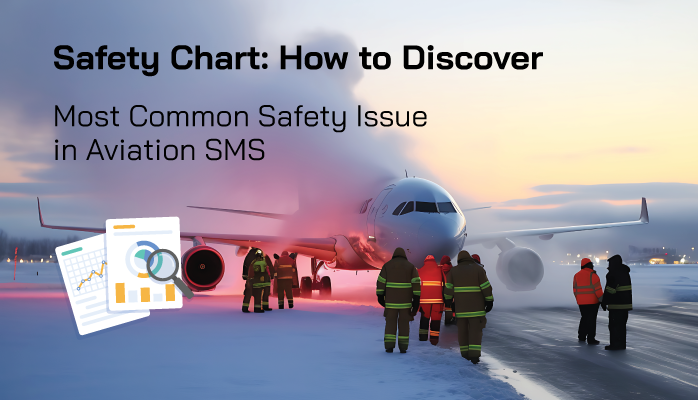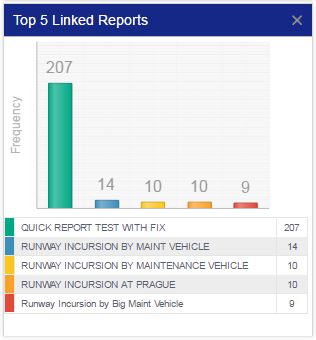Why Linked Safety Issues Chart Is Important

Compliance in aviation safety management systems (SMS) will become universally consistent for the most part. Sure, there will be regions where regulatory oversight remains inconsistent, but we'll not consider those operators at this time.
During SMS implementation, each operator will need to adapt its operations to embrace changes in "how they do business" to meet SMS requirements. While SMS requirements are basically the same across the world, how they are implemented varies from operator to operator, depending mostly on size and operational complexity.
An SMS implementation must be aligned with organizational goals and objectives. What does that really mean?
Related Aviation SMS Implementation Articles
- Why Should We Implement Aviation SMS?
- Aviation SMS Implementation Struggles and Solutions
- Is Your Aviation SMS Implementation a Farce? - With Self Assessments
Wholehearted adoption is not always realistic for every operator. That being said, not every accountable executive is expecting a fully functioning SMS.
A "paper SMS" that checks the box may be what an accountable executive expects. This is sensible when an SMS does not align with the corporate goals. Then there are the operators who spare no expense on SMS. Their entire organization is on board. Safety reporting metrics are great and the organization is benefiting financially from the SMS. So there are two extremes on this spectrum:
- Paper SMS; and
- Super SMS.
Chances are you are somewhere in-between. However, as you probably well know, each aviation SMS will also need to address and overcome its own unique safety performance barriers.
One particular roadblock to safety performance that many safety teams need to overcome is the detail in which they document their risk management processes. We've all heard the saying: "garbage-in, garbage-out." The same applies when safety teams do not properly document and classify reported safety issues during the reactive and proactive risk management processes.
There are benefits to having the proper SMS database tools to manage reported safety issues and audit findings, but safety teams won't completely realize those benefits unless they use the tools as they were designed. By fully understanding the purpose and power of your SMS database, safety teams will provide senior executives with very valuable fact-based decision-making reports.
Why Does This Always Happen to Us?

One of these most important reports should address a common problem that every organization has. How do you fix the problem that keeps coming up? For example, what is a problem in your company that keeps recurring?
- Communication breakdown?
- Chemicals?
- Unaccounted tools?
- Equipment failure?
- Fatigue?
- Jet blast?
- Wildlife?
Your recurring issue doesn't have to be an expensive problem, but when it happens time after time, the time to manage the issue may deliver sticker shock to the accountants. Obviously, "your recurring problem" is a prime safety issue to run through your risk management processes "in all earnestness." When the same issue occurs repeatedly, year after year, what does this say about the safety performance of the SMS? As such, an effective strategy for getting a solid idea about such specific performance barriers is to look for thematic issue occurrences.
Hence the usefulness and power that the ability to link (associate) safety issues to each other provides to maturing and mature SMS implementations.
Related Aviation SMS Performance Monitoring Chart Articles
- How to Monitor Aviation Safety Reporting Culture Using Safety Charts
- SMS Chart: Where to Focus Hazard Identification Training & Risk Mitigation
- Safety Chart: How to Monitor Aviation Risk Management Priorities Using Heat Maps
How to Identify Recurring Safety Concerns
The process of "linking safety issues" happens in the middle or late stages of the risk management process. This process of association could be done earlier also, such as when safety managers are assessing a newly reported safety issue, and they create an association between the newly reported issue with an older, similar issue(s) that had been treated in the risk management system.
Alternatively, associations may be made during a more structured safety committee meeting when there is more tribal knowledge gathered that has a broader familiarity with the company's historical safety issues.
For operators that use an SMS database, such as SMS Pro, the process of associating safety issues with each other is very simple. The first thing the database must determine is: What sort of safety issues have happened in the past that may be related to this current safety issue?
An SMS database makes very short work of this when safety managers are classifying safety issues in a consistent and logical manner. The similarity between safety issues is usually based on similarities resulting from the classification process, such as when two safety issues that share the same classifications for:
- Human Factor(s);
- Types of issues;
- Hazards from Hazard Register;
- Root Causes; or
- Policy or Procedure.
A good example of linking safety issues would be in the event of a runway incursion. Older runway incursions would naturally share some of the same classifications. With a professional aviation SMS database, similar issues would automatically populate for safety managers to choose to link.
Even in SMS data management systems that are manually managed, such as spreadsheets, a safety manager only needs to notate the ID of a similar issue to associate. It won't be pretty doing it manually, but then not all accountable executives expect much from their SMS. If you can pull off this feat using spreadsheets, you will be a rock star.
Related Aviation SMS Performance Monitoring Chart Articles
- Safety Chart: How Effective Is Hazard Identification Training in Aviation SMS?
- Safety Chart: How to Track Safety Reporting Performance in Aviation SMS
- How to Monitor Aviation SMS Responsiveness Using Safety Charts
Situations When This Safety Performance Chart Is Very Useful

This chart will prove extremely useful in several different situations:
- Preparing for aviation safety audits;
- Routine SMS performance monitoring;
- During periodic review of risk controls;
- In the creation of safety procedures and policies; and
- In the most relevant safety promotional tools, such as safety training, safety newsletters, and safety messages.
The reason this chart proves so useful in these situations is that each use-case involves preventative tasks. Preventative tasks are simply those that prepare for future events – i.e. procedures prepare against the wrong way of doing things, safety training prepares for better safety behavior, and so on.
Knowing what type of behavior to prevent necessarily involves seeing your aviation SMS' historical patterns, which is exactly why this chart is so useful.
In our chart example above, you can see that the #2-5 linked safety issues are all runway incursions. Three of the safety issues are reports of runway incursions by a maintenance vehicle. In a real-world scenario, they would all share the same linked safety issue for maintenance vehicle runway incursions, which is a very good indication that this example problem would need some considerable controls to prepare for what is obviously a thematic problem for our example organization.
If you have been linking safety issues in your own SMS risk management activities, no doubt that you see similar themes that are specific to your organization. When reviewing and updating policies and training, you will have a much more solid idea about what your aviation SMS needs than if you were not linking safety issues.
What This Safety Chart Reveals About Your Aviation SMS
As said several times, this chart reveals the unique struggles that impact your SMS performance. Again, we are talking about safety performance and not safety compliance performance.
Over time, this chart will reveal the particular, pesky themes in the hazards and risks that are most relevant to your operations. Of course, ideally, these themes will not remain static over time. The reason for this is basically because of drift:
- Work environment, dynamic, and employees will change;
- Controls will become out of date/erode; and
- Controls for consistent-similar issues will improve and no longer be as thematic.
In our example, this chart looks at the entire history of the SMS implementation, but if this chart were to filter in different time periods, such as Top 5 Linked Reports within the past year, it can be used to see emerging themes in your SMS implementation.
Related Aviation SMS Performance Monitoring Chart Articles
- Safety Chart: How to Monitor Overall Risk Exposure of Aviation SMS
- How to Monitor Aviation SMS Performance - Safety Chart
- Safety Chart: Learning Who Is (or Isn't) Involved in Your Aviation SMS
How Linked Safety Issues Charts Are Created
As discussed, this chart is created in one of two ways:
- Manually, when using spreadsheets; and
- Automatically, when you have access to an SMS database software.
In the case of aviation SMS software, linked safety issues will automatically tabulate when safety managers associate new safety reports with older safety reports. In the case of SMS Pro, the database looks for similarities with other safety issues' classifications. Then it presents the shortlist to safety managers, who then determine whether the similarities warrant a "match" with the current safety issue.
Manually managed aviation SMS spreadsheets can easily associate reports by notating the associated ID with the new issue, keeping that information in their own system (i.e. Excel), and then filtering for associated IDs to generate the resulting list.
How This Chart Relates to SMS Requirements

In terms of ICAO's four pillars, this chart is very much in line with Safety Assurance activities.
Linked safety reports indicate to safety managers the effectiveness of the
- safety reporting system;
- hazard identification capabilities of employees;
- safety culture;
- risk management capabilities of the safety team; and
- data management capabilities of the SMS.
This chart also is useful in routinely monitoring the effectiveness of safety risk controls, as well as which further items are needed for:
- Strengthening existing risk controls;
- Aviation SMS training; and
- SMS policies and procedures.
Related Aviation SMS Performance Monitoring Chart Articles
- Safety Chart: Monitor Aviation SMS Performance With Leading Indicators
- Safety Chart: Visually Presenting Aviation SMS KPIs - With Free KPI Resources
- Safety Chart: Mandatory vs. Voluntary Aviation SMS Issues to Report
Final Thoughts to Discover Recurring Safety Concerns
We live in a fast-paced world. Information bombards us constantly and it becomes difficult to organize and categorize all safety information entering the SMS. When safety managers are treating 50 to 60 reported safety issues each month, it becomes more difficult to detect trends and predict future events without the use of powerful, SMS databases.
An SMS database powers sophisticated safety performance dashboards, delivering decision-making value in real time. A low-cost, commercially available SMS database also gives management immediate access to repeatable risk management processes that are used across the industry. Furthermore, an SMS database gives safety teams the necessary tools to get to the bottom of these recurring safety issues that keep haunting organizations year after year.
To learn how your SMS can benefit from a low-cost, commercially available SMS database, please watch these short demo videos.
A very useful performance monitoring dashboard comes with every SMS Pro solution.
Last updated January 2025.








